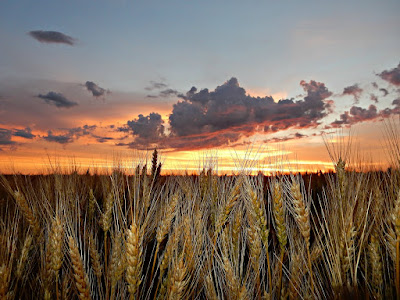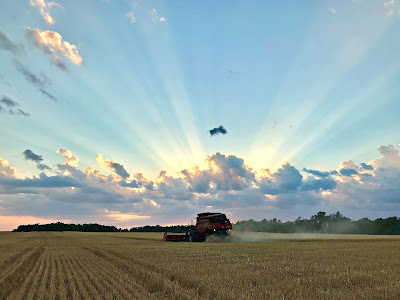 | |
| Photo note: This and all the other photos in this post - with the labeled exception - are from the Kim's County Line archive. |
It may seem an archaic custom in 2024. But, back when I was a teenager in the 1970s, girls often received "hope chests" as gifts. Historically, it was a place to store linens and other household goods and the cedar-lined box kept away moths and pests. I believe I got my hope chest when I graduated from high school. It still sits in our bedroom and has my kids' outfits they wore when they came home from the hospital, among other "treasures."
But it was a "hope chest" of another kind that continues to impact
Kansas today. This chest delivered Turkey Red Wheat seed
thousands of miles from the Ukraine to the United States, where
Mennonites looking for religious freedom hoped to make a new life. And
they did just that, planting the wheat kernels that helped transform Kansas'
wheat industry.
 |
| Seed chest exhibited at the Mennonite Heritage and Agricultural Museum, Goessel, KS. Photo from History.com |
Bernhard Warkentin, the son of a Mennonite miller who is credited with setting up Ukraine’s prosperous wheat industry, came to the United States in 1871 to scout possible sites to do the same in America. Along with several of his fellow Mennonites, he traveled for two years by both horse and train covering a distance of over 10,000 miles in places like Canada, the Dakotas and Minnesota, looking for the ideal terrain.
In 1874, Warkentin settled in Halstead, Kansas, building a grist mill on the banks of the Little Arkansas River and encouraging other Mennonites to join him. Some 12,000 Mennonites moved to Kansas, mainly as a result of Warkentin's efforts. Many of them became wheat farmers.
Wheat Harvest 2024 got under way in our area on Saturday, before being curtailed by a nice 1.70 inches of rain Saturday night into Sunday morning. (The rain was too late to help this year's wheat, but it certainly helped the spring-planted corn and soybean crops, alfalfa, pasture lands and farm ponds. Nobody around here was complaining about the delay to wheat harvest.)
Maybe the start and stop story of harvest is not so different from that of those immigrating farmers years ago. Certainly, the ultimate goal has not changed - using the land to produce food and fiber for the world while also providing for our own families.
During Wheat Harvest 2024, we celebrate 150 years of Turkey Red Winter Wheat in Kansas.
Before the Mennonites came to the region, many farmers who'd moved from the eastern regions of the U.S. were planting spring wheat, which was more acclimated for the Eastern seaboard. However, Kansas’s summers are hot, dry and windy, not ideal for wheat seedlings to thrive and produce a crop. On top of that, grasshopper swarms in the summer would completely devour what wheat did manage to survive.
But the influx of Turkey Red - a hardy winter wheat - was more suited to Kansas' climate.
At the same time, railroad lines expanded, communities were settled and giant elevators to store grain were built.
Turkey Red Wheat was one of the more popular varieties of wheat in Kansas until the 1940s, when higher–yield crops overtook it. But even today's varieties can trace their pedigrees back to foundations in Turkey Red hard winter wheat or other Crimean varieties. Kansas wheat accounts for nearly 20 percent of all wheat grown in the United States today.
Maybe the old farmers in the region looked at skepticism at those new farmers who brought different seeds and a different planting time table to the Kansas plains. However, Turkey Red winter wheat - and, ultimately, its descendants - were here to stay.
 |
| Harvest 2021 |
Bernard Warkentin likely never dreamed that the seeds he and his Mennonite brethren were bringing to Kansas could one day lead to the state growing 244.2 million bushels of wheat in 2022, or 18 to 20 percent of the wheat crop of the United States. He may not have imagined that wheat production in the state would account for $4.3 billion of its economy and 15,245 jobs. Or that in 2023, half of every load of wheat that arrives at the local elevator would be destined for foreign buyers.
But, I'm sure glad he included Turkey Red wheat in his own "hope chest" as he left all he knew behind for a new adventure in a new land.
***
And, to learn more about Turkey Red wheat’s influence in Kansas agriculture, listen to Kansas Wheat’s “Wheat’s on Your Mind: Thresher Nation” podcast episode, Wheat's on Your Mind, with Aaron Harries of Kansas Wheat and Glenn Ediger, author of “Leave No Threshing Stone Unturned,” a book about the Mennonites and Turkey Red wheat.







.jpg)



Thank you 😊
ReplyDeleteYou're welcome!
Delete